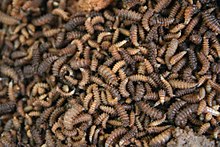
Forensic entomology is a field of forensic science that uses insects found on corpses to help solve criminal cases. This includes the study of insect types commonly associated with cadavers, their respective life cycles, their ecological presences in a given environment, as well as the changes in insect assemblage with the progression of decomposition. Insect succession patterns are identified based on the time a given species of insect spends in a given developmental stage, and how many generations have been produced since the insects introduction to a given food source. Insect development alongside environmental data such as temperature and vapor density, can be used to estimate the time since death, due to the fact that flying insects are attracted to a body immediately after death, determine any possible movement of the body after death, and the determination of antemortem trauma. The identification of postmortem interval to aid in death investigations is the primary scope of this scientific field. However, forensic entomology is not limited to homicides, it has also been used in cases of neglect and abuse, in toxicology contexts to detect the presence of drugs, and in dry shelf food contamination incidents. Equally, insect assemblages present on a body, can be used to approximate a given location, as certain insects may be unique to certain areas. Therefore, forensic entomology can be divided into three subfields: urban, stored-product and medico-legal/medico-criminal entomology.
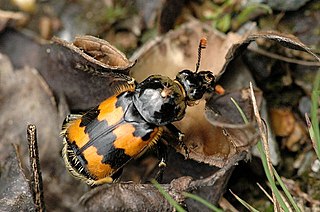
Silphidae is a family of beetles that are known commonly as large carrion beetles, carrion beetles or burying beetles. There are two subfamilies: Silphinae and Nicrophorinae. Members of Nicrophorinae are sometimes known as burying beetles or sexton beetles. The number of species is relatively small, at around two hundred. They are more diverse in the temperate region although a few tropical endemics are known. Both subfamilies feed on decaying organic matter such as dead animals. The subfamilies differ in which uses parental care and which types of carcasses they prefer. Silphidae are considered to be of importance to forensic entomologists because when they are found on a decaying body they are used to help estimate a post-mortem interval.

Decomposition or rot is the process by which dead organic substances are broken down into simpler organic or inorganic matter such as carbon dioxide, water, simple sugars and mineral salts. The process is a part of the nutrient cycle and is essential for recycling the finite matter that occupies physical space in the biosphere. Bodies of living organisms begin to decompose shortly after death. Animals, such as earthworms, also help decompose the organic materials. Organisms that do this are known as decomposers or detritivores. Although no two organisms decompose in the same way, they all undergo the same sequential stages of decomposition. The science which studies decomposition is generally referred to as taphonomy from the Greek word taphos, meaning tomb. Decomposition can also be a gradual process for organisms that have extended periods of dormancy.
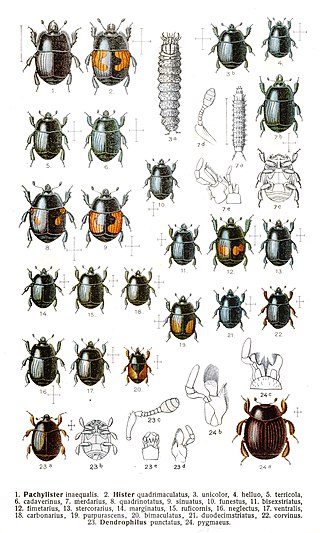
Histeridae is a family of beetles commonly known as clown beetles or hister beetles. This very diverse group of beetles contains 3,900 species found worldwide. They can be easily identified by their shortened elytra that leaves two of the seven tergites exposed, and their geniculate (elbowed) antennae with clubbed ends. These predatory feeders are most active at night and will fake death if they feel threatened. This family of beetles will occupy almost any kind of niche throughout the world. Hister beetles have proved useful during forensic investigations to help in time of death estimation. Also, certain species are used in the control of livestock pests that infest dung and to control houseflies. Because they are predacious and will even eat other hister beetles, they must be isolated when collected.

Trogidae, sometimes called hide beetles, is a family of beetles with a distinctive warty or bumpy appearance. Found worldwide, the family includes about 300 species contained in four or five genera.

Cleridae are a family of beetles of the superfamily Cleroidea. They are commonly known as checkered beetles. The family Cleridae has a worldwide distribution, and a variety of habitats and feeding preferences.

Calliphora vomitoria, known as the blue bottle fly, orange-bearded blue bottle, or bottlebee, is a species of blow fly, a species in the family Calliphoridae. Calliphora vomitoria is the type species of the genus Calliphora. It is common throughout many continents including Europe, Americas, and Africa. They are fairly large flies, nearly twice the size of the housefly, with a metallic blue abdomen and long orange setae on the gena.
Forensic entomological decomposition is how insects decompose and what that means for timing and information in criminal investigations. Medicolegal entomology is a branch of forensic entomology that applies the study of insects to criminal investigations, and is commonly used in death investigations for estimating the post-mortem interval (PMI). One method of obtaining this estimate uses the time and pattern of arthropod colonization. This method will provide an estimation of the period of insect activity, which may or may not correlate exactly with the time of death. While insect successional data may not provide as accurate an estimate during the early stages of decomposition as developmental data, it is applicable for later decompositional stages and can be accurate for periods up to a few years.

Phormia regina, the black blow fly, belongs to the blow fly family Calliphoridae and was first described by Johann Wilhelm Meigen.

Chrysomya megacephala, more commonly known as the oriental latrine fly or oriental blue fly, is a member of the family Calliphoridae (blowflies). It is a warm-weather fly with a greenish-blue metallic box-like body. The fly infests corpses soon after death, making it important to forensic science. This fly is implicated in some public health issues; it can be the cause of myiasis, and also infects fish and livestock.
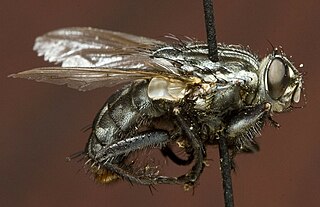
Sarcophaga bullata, or the grey flesh fly, is a species of fly belonging to the family Sarcophagidae. It varies in size from small to large, 8 to 17 millimeters in length and is very similar in appearance and behavior to a closely related species, Sarcophaga haemorrhoidalis. S. bullata is a common scavenger species in the Eastern United States, but is found throughout the Nearctic region. Identification down to the species level in the family Sarcophagidae is notably difficult and relies primarily on the male genitalia. Though limited information is available regarding S. bullata, it has gained increasing recognition in the field of forensic entomology as a forensically relevant fly species, as it may be among the first species to colonize human remains. In these instances, recovered maggots may be analyzed for post-mortem interval (PMI) estimations, which may be used as evidence in courts of law. Current studies regarding S. bullata have revealed a maternal effect operating in these flies that prevents pupal diapause under certain environmental conditions, which is an important factor to be considered during forensic analyses.
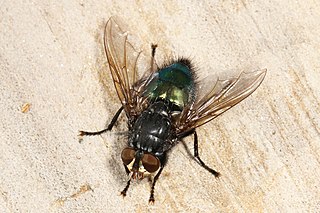
Cynomya cadaverina, also known as the shiny blue bottle fly, is a member of the family Calliphoridae, which includes blow flies as well as bottle flies. In recent years, this family has become a forensically important facet in many medicocriminal investigations in the growing field of forensic entomology. C. cadaverina is specifically important in determining a post-mortem interval, as well as other important factors.

Lucilia coeruleiviridis, formerly Phaenecia coeruleiviridis, is commonly known as a green bottle fly, because of its metallic blue-green thorax and abdomen. L. coeruleiviridis was first discovered by French entomologist Pierre-Justin-Marie Macquart in 1855. It belongs to the family Calliphoridae and is one of many forensically important Diptera, as it is often found on decaying substances. L. coeruleiviridis is one of the most ubiquitous blow fly species in the southeastern United States, particularly in the spring and fall months.
Calliphora latifrons is a species of blue bottle fly.

Creophilus maxillosus, the hairy rove beetle, is a species of rove beetle.

Oiceoptoma noveboracense is a member of the family Silphidae, or carrion beetles, which feed on decaying organic matter such as dead animals. Its common name is the margined carrion beetle, from the orange-red margins on the pronotum, which are helpful when identifying this species. The larva is typically light brown to red and also has vertical ridges on its thorax like the adult. This diurnal beetle can be found mainly in the spring into the fall, and it has a strong preference towards a deciduous forest habitat. The primary forensic importance of this beetle is its ability to use the succession of insect fauna to provide confirmation of postmortem intervals.

Necrophages are organisms that obtain nutrients by consuming decomposing dead animal biomass, such as the muscle and soft tissue of carcasses and corpses. The term derives from Greek nekros, meaning 'dead', and phagein, meaning 'to eat.' Mainly, necrophages are species within the phylum Arthropoda; however, other animals, such as gastropods and Accipitrimorphae birds have been noted to engage in necrophagy.
The necrobiome has been defined as the community of species associated with decaying corpse remains. The process of decomposition is complex. Microbes decompose cadavers, but other organisms including fungi, nematodes, insects, and larger scavenger animals also contribute. Once the immune system is no longer active, microbes colonizing the intestines and lungs decompose their respective tissues and then travel throughout the body via the blood and lymphatic systems to break down other tissue and bone. During this process, gases are released as a by-product and accumulate, causing bloating. Eventually, the gases seep through the body's wounds and natural openings, providing a way for some microbes to exit from the inside of the cadaver and inhabit the outside. The microbial communities colonizing the internal organs of a cadaver are referred to as the thanatomicrobiome. The region outside of the cadaver that is exposed to the external environment is referred to as the epinecrotic portion of the necrobiome, and is especially important when determining the time and location of death for an individual. Different microbes play specific roles during each stage of the decomposition process. The microbes that will colonize the cadaver and the rate of their activity are determined by the cadaver itself and the cadaver's surrounding environmental conditions.
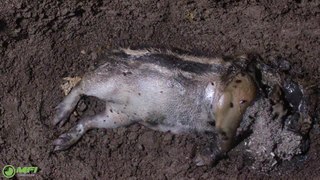
Decomposition is the process in which the organs and complex molecules of animal and human bodies break down into simple organic matter over time. In vertebrates, five stages of decomposition are typically recognized: fresh, bloat, active decay, advanced decay, and dry/skeletonized. Knowing the different stages of decomposition can help investigators in determining the post-mortem interval (PMI). The rate of decomposition of human remains can vary due to environmental factors and other factors. Environmental factors include temperature, burning, humidity, and the availability of oxygen. Other factors include body size, clothing, and the cause of death.

Necrodes littoralis, also known as the short sexton beetle, is a species of carrion beetle of the genus Necrodes, found in countries across Europe. As a carrion beetle, it feeds on decaying vertebrate remains and maggots. This species' feeding behaviors make it an important asset to forensic entomology.



